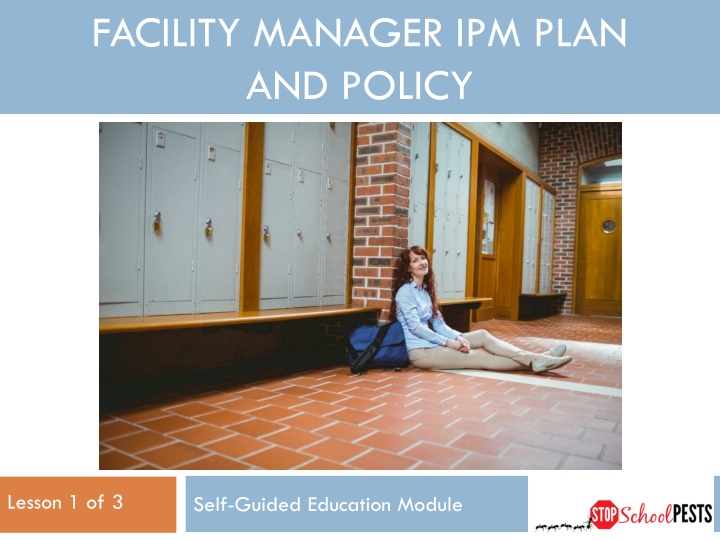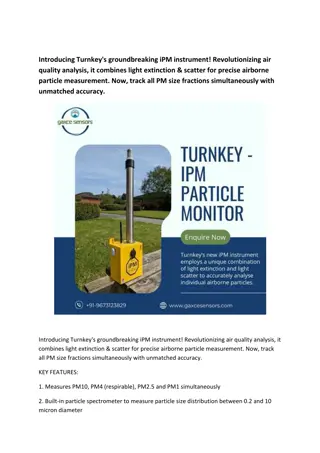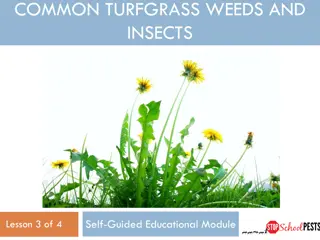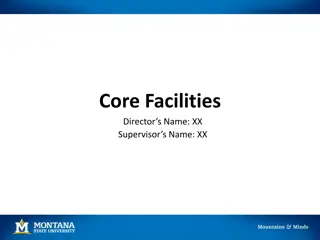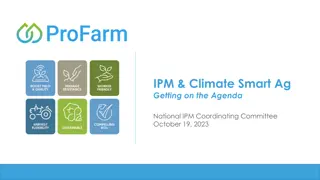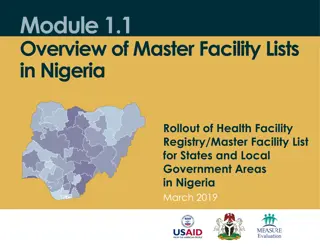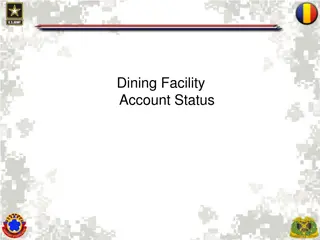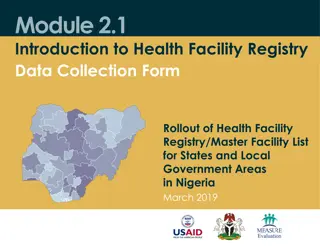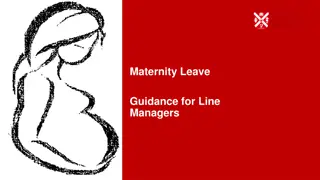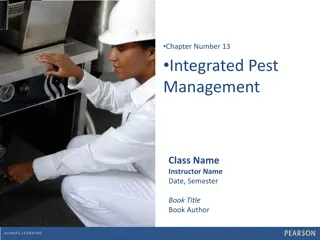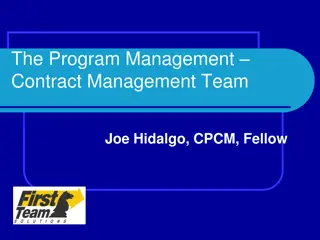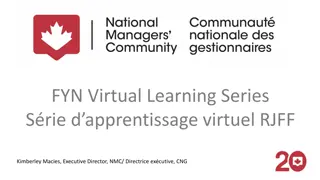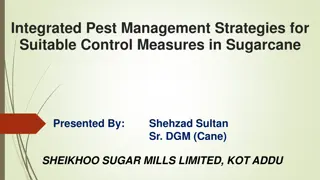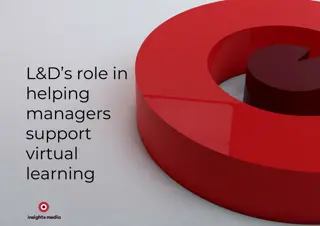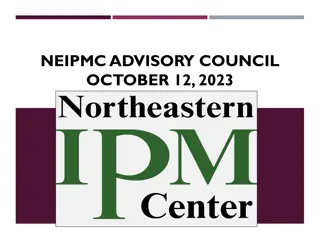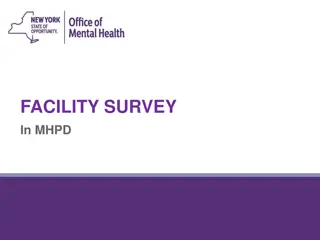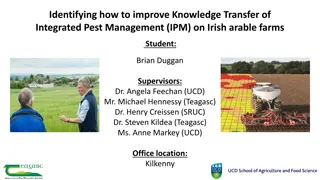Essential Elements of IPM Policy and Plan for Facility Managers
Understanding the key elements of an IPM policy and plan is crucial for successfully implementing an Integrated Pest Management program. This self-guided education module covers writing IPM policies and plans, securing formal approval, implementing and maintaining policies, and more. It emphasizes the importance of having a clear IPM policy to transition from conventional pesticide-based programs, setting specific program goals, involving the community, and committing to pest prevention. The module also provides a template for an IPM plan and guidance for effective pest management strategies.
Download Presentation

Please find below an Image/Link to download the presentation.
The content on the website is provided AS IS for your information and personal use only. It may not be sold, licensed, or shared on other websites without obtaining consent from the author.If you encounter any issues during the download, it is possible that the publisher has removed the file from their server.
You are allowed to download the files provided on this website for personal or commercial use, subject to the condition that they are used lawfully. All files are the property of their respective owners.
The content on the website is provided AS IS for your information and personal use only. It may not be sold, licensed, or shared on other websites without obtaining consent from the author.
E N D
Presentation Transcript
FACILITY MANAGER IPM PLAN AND POLICY Lesson 1 of 3 Self-Guided Education Module
Learning Objectives 2 1. Describe key elements of an IPM policy and plan and their relationship to an IPM program including: a. Writing IPM policies and plans b. Securing formal approval of an IPM policy and plan c. Implementing and maintaining an IPM policy and plan including recordkeeping and evaluation
1. School IPM Policy 3 A clear IPM policy is necessary for successful transition from a conventional pesticide-based program to an IPM program It is an important tool to have in support of establishing IPM long-term An IPM policy expresses your district s commitment to IPM
Policy Continued 4 The policy should be short and concise and explain the intention the district has to implement and practice IPM by setting specific program goals and objectives A school board-approved IPM policy allows the entire community to participate in developing the program, and provides an effective way to respond to questions A strong community equals a sustainable program
Policy Continued 5 Implementing pest prevention is important - The policy should commit to preventing pests and reducing pest-conducive conditions as ongoing tasks requiring and participation from all parties IPM components include: A. Sanitation Pest exclusion B. C. Habitat modification D. Pesticides necessary based on inspection and monitoring
Policy Continued 6 The policy can include general provisions addressing clutter, sanitation and maintenance, providing a tool to help principals and other administrators get cooperation from staff The IPM coordinator is responsible for day-to- day interpretation of the IPM policy The policy guides development of a detailed IPM plan that must comply with the policy
2. IPM Plan Template 7 The IPM plan is a blueprint detailing how your district or school will manage pests through prevention, monitoring and control methods A helpful guidance document can be found at http://extension.arizona.edu/sites/extension.arizona.edu/files /pubs/az1669-2015.pdf The plan is managed by the IPM Coordinator and eases transitions when key staff change Your plan will be a living (changing) document updated annually or more often if needed
Your IPM Plan Should Include: 8 A copy of your school IPM policy General information about your district The name and title of your school IPM coordinator The names and titles of your school IPM or environmental health committee members Identification and description of the pests that occur in your district and both chemical and non-chemical measures used to manage those pests 1. 2. 3. 4. 5.
Your IPM Plan Should Include: 9 Description of your school IPM information flow, including a description of the location of your school IPM plan and pest log and application records A list of pre-approved or preferred pesticide(s) that may be applied on school property when non-chemical measures do not provide adequate control 6. 7.
General Information 10 School/District name Address City Zip Code Telephone number E-mail address Website Prepared by Date prepared
3. The IPM Coordinator 11 The district should appoint an IPM Coordinator who will have primary responsibility for ensuring that the IPM program, through the policy and plan, is carried out The selection and choice of an IPM Coordinator is very important to the success and sustainability of an IPM program - The IPM Coordinator must be trained to: Oversee staff to ensure implementation of pest prevention measures Oversee and coordinate the activities of the IPM Committee
IPM Coordinator Continued 12 Manage pest control contractors engaged in inspecting, monitoring and control of pest problems Communicate with principals and district administration to carry out posting and notification, recordkeeping and education on the policy and plan Ensure compliance with the IPM policy and plan, and maintain the plan to ensure it reflects current conditions and practices
IPM Coordinator Continued 13 School facility managers, or individuals who have facility management leadership as part of their position responsibilities, are generally good candidates for the IPM coordinator role In smaller districts without a dedicated facility manager, superintendents may be good candidates to serve as IPM coordinators Anyone serving in the IPM coordinator role should receive initial training and continuing education
4. The IPM Committee 14 The IPM committee consists of individuals who have interests/concerns or who are involved in activities directly or significantly related to pest management at the school Environmental health and safety or related committees may be charged with IPM responsibilities and thus serve as the IPM committee The IPM coordinator can lead or help organize communication and meetings for the committee
IPM Committee Continued 15 The committee: Makes policy recommendations based on current pest issues and evaluates possible IPM solutions Provides a forum for communication and information exchange among members in an effort to identify, encourage and stimulate the use IPM
IPM Committee Continued 16 Members can include the school nurse, a representative of the food service staff, a teacher representative, a custodian, a representative of the school athletic department, a parks superintendent or others who utilize the playing fields, the pest management professional, a PTA member, etc.
5. Identification and Description of Your School Pest Problem(s) 17 Pest identification is the on-going dynamic process of reporting and recording the pests in a school Proper identification and inventory of your pest problems is critical to understanding management needs and selection of the appropriate non-pesticide and pesticide response options
Identification and Description of Your School Pest Problem(s) Continued 18 Determine the most common pest problem(s) The following questions should be asked with every pest sighting: Is it a new or continuing problem? What specific areas are being impacted? What time of year does this pest problem occur? Is the problem related to specific structural deficiencies or sanitation problems?
Identification and Description of Your School Pest Problem(s) Continued 19 The IPM plan should encourage those non- pesticide pest management methods and practices such as good sanitation and pest proofing(caulking, sealing cracks, repairing screens), etc. Door in need of vertical sweeps Dawn H. Gouge, University of Arizona
6. Describe Your School IPM Information Flow 20 Describe how pest problems specific to your school will be reported - Indicate the type of reporting system and the information required Indicate who in the school will be responsible for responding to sanitation and building repair problems that are identified through inspection reports Describe how pesticide applications will be documented including what information will be recorded, where and by whom
Information Flow Continued 21 Describe how staff, faculty and parents will be educated, IPM coordinators usually teach and/or coordinate the education effort Records of pesticide use, non-chemical actions, service reports, pest-sighting logbook, posting, notification and emergency waivers should be kept at a central location readily available when needed
Information Flow Continued 22 Additional documents should include, Safety Data Sheets (SDSs), pesticide product labels and available manufacturer information about inert ingredients
Information Flow Continued - Pesticide Application Notification 23 All parents and staff should be notified of a pesticide application prior to any pesticide applications in buildings or on grounds, with the exception of exempt applications State law may or may not require notification, Facility Managers should review the legal requirements as he/she writes this section of the IPM Plan Parents may be notified each time a non-exempt pesticide is applied, or given guidance documents when students are enrolled
Pesticide Application Notification Continued 24 Signs should be posted on facility doors and near the site of planned applications at least three business days in advance of pesticide use, or at the time of application if it s an emergency application Pesticides in Use sign posted Dawn H. Gouge, University of Arizona
Pesticide Application Notification Continued 25 Outdoor application areas may be cordoned off and flagged Signs shall remain in place for 72 hours after a pesticide application, or a longer period of time if specified by the pesticide label, district policy or state law Pesticide Application sign posted Janet Hurley, Texas AgriLife Extension
7. Pre-approved or Preferred List of Pesticides 26 The IPM coordinator and committee should determine which pesticides may be used if non-chemical measures are not adequate The objective is to identify low-risk, effective options Green Category pesticide guide for schools in Texas Janet Hurley, Texas AgriLife Extension
Secure Formal Approval of an IPM Policy and Plan 27 It s helpful to document the formal acceptance and endorsement of the IPM Policy/Plan by: The district Environmental Health Committee The District superintendent The School Board The State Department of Education or Tribal Council PTO/PTA
Maintain the IPM Policy and Plan 28 At a minimum, the IPM plan should be evaluated annually Is the IPM plan working? What changes are necessary? Has new technology replaced some of the former pest control tactics? Have federal, state or local rules changed?
Additional Documents: Pest-Sighting Logs 29 Facility Management should keep records of: Information on the number of pests or other indicators of pest activity that can verify the need for action Pest logs are used by facilities managers, kitchen staff, teachers and others to alert IPM managers and the IPM Coordinator of a looming problem Evaluating pest logs can also assist in identifying trends such as weaknesses in sanitation, cluttering and behavior problems that may need to be addressed Logs can be part of an existing electronic work-order system
Additional Documents: Pesticide Application Logs 30 Records of pesticide use shall be maintained on site to meet the requirements of applicable regulatory agencies The objective is to create records from which programs and practices can be evaluated in order to improve the system and eliminate ineffective treatments Pesticide application records Rite in the Rain, JL DARLING LLC, WA
Check In! 31 In this lesson you learned 1. How to describe key elements of an IPM Policy and Plan and their relationship to an IPM Program including: a. Writing IPM policies and plans b. Secure formal approval of an IPM policy and plan c. Implementing and maintaining an IPM policy and plan Next you will learn about other facility manager responsibilities!
Resources 32 How to Develop an Integrated Pest Management (IPM) Policy and Plan for Your School District. PENN STATE. Retrieved from http://extension.psu.edu/pests/ipm/schools/facilitiesmanagers /resourcespaschools/faq/ipmschoolplan National Center for Environmental Health. (2009). Healthy Housing Reference Manual. Retrieved from http://www.cdc.gov/nceh/publications/books/housing/figure_ cha04.htm New Jersey Department of Environmental Protection Pesticide Control Program. How to Do IPM at School A How to Manual for New Jersey Schools. Retrieved from http://www.state.nj.us/dep/enforcement/pcp/bpc/ipm/How_t o_Do_IPM.pdf
